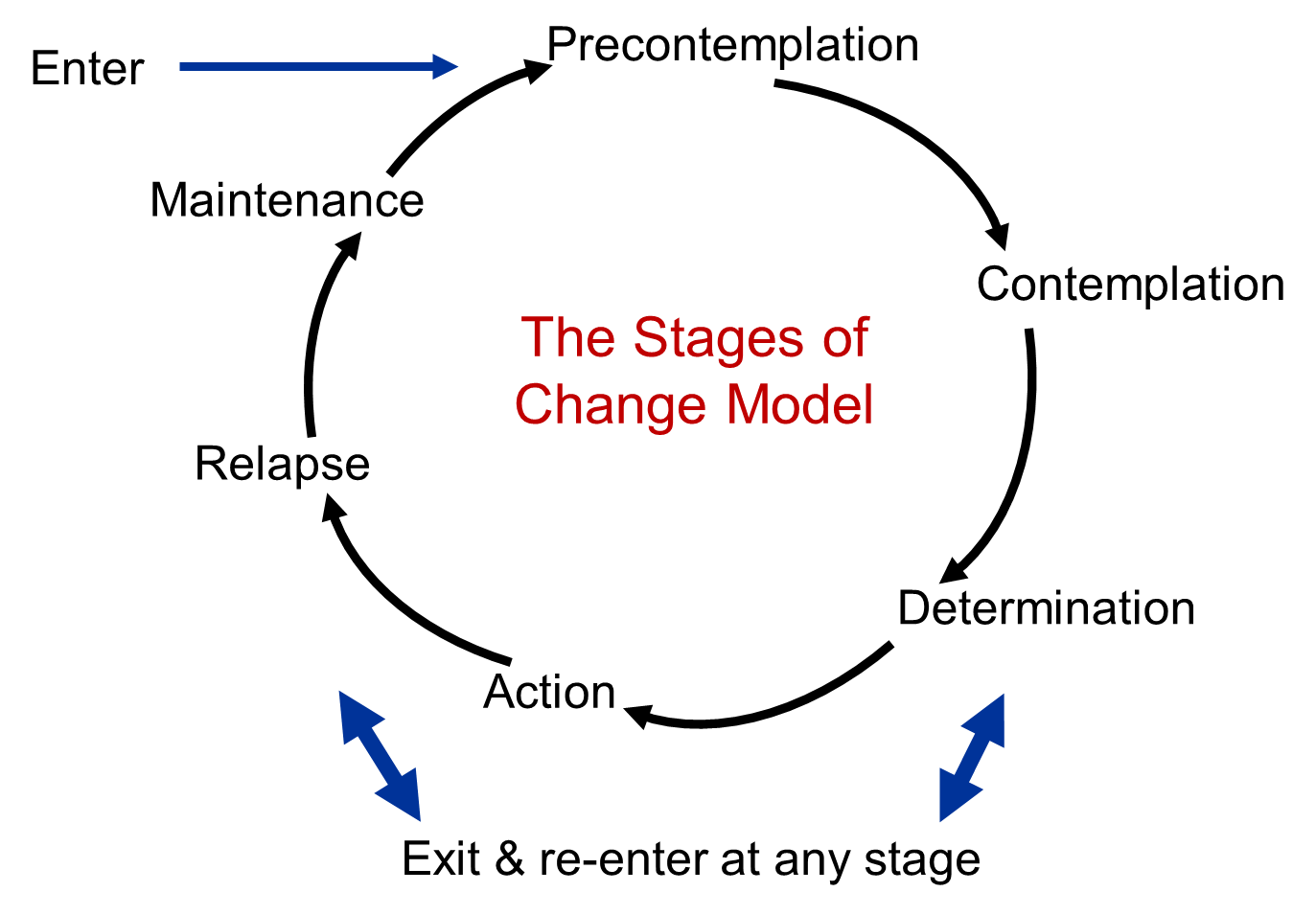Which Of The Following Statements Is True Of The Maintenance Stage Of The Change Model?
The Transtheoretical Model (Stages of Change)
The Transtheoretical Model (as well called the Stages of Modify Model), adult past Prochaska and DiClemente in the late 1970s, evolved through studies examining the experiences of smokers who quit on their own with those requiring farther treatment to sympathize why some people were capable of quitting on their own. It was determined that people quit smoking if they were ready to exercise so. Thus, the Transtheoretical Model (TTM) focuses on the controlling of the individual and is a model of intentional change. The TTM operates on the assumption that people do not change behaviors quickly and decisively. Rather, modify in behavior, especially habitual behavior, occurs continuously through a cyclical process. The TTM is not a theory but a model; different behavioral theories and constructs tin can exist applied to diverse stages of the model where they may exist nigh constructive.
The TTM posits that individuals move through six stages of change: precontemplation, contemplation, preparation, activeness, maintenance, and termination. Termination was not part of the original model and is less frequently used in awarding of stages of modify for health-related behaviors. For each stage of modify, different intervention strategies are nigh effective at moving the person to the adjacent stage of change and subsequently through the model to maintenance, the platonic phase of behavior.
- Precontemplation - In this stage, people exercise not intend to accept activity in the foreseeable future (defined every bit within the next 6 months). People are often unaware that their behavior is problematic or produces negative consequences. People in this phase often underestimate the pros of changing beliefs and place too much emphasis on the cons of changing behavior.
- Contemplation - In this stage, people are intending to start the healthy behavior in the foreseeable future (defined as inside the next 6 months). People recognize that their behavior may be problematic, and a more thoughtful and practical consideration of the pros and cons of irresolute the beliefs takes identify, with equal emphasis placed on both. Fifty-fifty with this recognition, people may still experience ambivalent toward changing their behavior.
- Preparation (Determination) - In this phase, people are set up to have activity within the next thirty days. People offset to take small steps toward the behavior change, and they believe irresolute their behavior can lead to a healthier life.
- Action - In this stage, people have recently changed their behavior (defined as within the last half dozen months) and intend to keep moving forward with that behavior change. People may exhibit this past modifying their problem behavior or acquiring new healthy behaviors.
- Maintenance - In this stage, people have sustained their behavior change for a while (divers as more than 6 months) and intend to maintain the behavior change going forward. People in this stage piece of work to forbid relapse to earlier stages.
- Termination - In this stage, people have no desire to return to their unhealthy behaviors and are sure they volition not relapse. Since this is rarely reached, and people tend to stay in the maintenance phase, this stage is frequently not considered in health promotion programs.

To progress through the stages of change, people apply cognitive, affective, and evaluative processes. 10 processes of change have been identified with some processes being more relevant to a specific stage of change than other processes. These processes effect in strategies that help people make and maintain change.
- Consciousness Raising - Increasing sensation about the healthy behavior.
- Dramatic Relief - Emotional arousal about the health beliefs, whether positive or negative arousal.
- Self-Reevaluation - Self reappraisal to realize the healthy behavior is part of who they desire to exist.
- Ecology Reevaluation - Social reappraisal to realize how their unhealthy behavior affects others.
- Social Liberation - Environmental opportunities that exist to evidence society is supportive of the healthy beliefs.
- Cocky-Liberation - Commitment to change beliefs based on the belief that achievement of the good for you behavior is possible.
- Helping Relationships - Finding supportive relationships that encourage the desired alter.
- Counter-Conditioning - Substituting salubrious behaviors and thoughts for unhealthy behaviors and thoughts.
- Reinforcement Management - Rewarding the positive behavior and reducing the rewards that come up from negative behavior.
- Stimulus Control - Re-engineering science the surround to have reminders and cues that back up and encourage the healthy beliefs and remove those that encourage the unhealthy behavior.
Limitations of the Transtheoretical Model
In that location are several limitations of TTM, which should be considered when using this theory in public health. Limitations of the model include the following:
- The theory ignores the social context in which alter occurs, such equally SES and income.
- The lines between the stages can be arbitrary with no set criteria of how to determine a person'south stage of change. The questionnaires that have been developed to assign a person to a stage of change are not always standardized or validated.
- There is no clear sense for how much time is needed for each stage, or how long a person can remain in a phase.
- The model assumes that individuals brand coherent and logical plans in their determination-making process when this is non always true.
The Transtheoretical Model provides suggested strategies for public wellness interventions to accost people at various stages of the decision-making process. This can result in interventions that are tailored (i.east., a message or program component has been specifically created for a target population'south level of knowledge and motivation) and effective. The TTM encourages an assessment of an private's current stage of change and accounts for relapse in people'due south controlling procedure.
Source: https://sphweb.bumc.bu.edu/otlt/mph-modules/sb/behavioralchangetheories/behavioralchangetheories6.html
Posted by: hernandezantionne.blogspot.com


0 Response to "Which Of The Following Statements Is True Of The Maintenance Stage Of The Change Model?"
Post a Comment